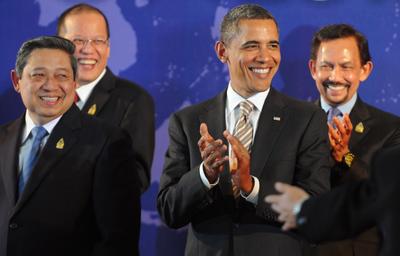The current US policy toward ASEAN also represents an attempt at complementing and deepening bilateral ties with Southeast Asian countries — especially Indonesia and Vietnam. The Obama administration wants to encourage the formation of a multilateral security architecture in Asia that will include the US and complement its bilateral defence and foreign policy commitments.
Unlike Obama, the Bush administration was seen as being largely uninterested in actively fostering East Asian cooperation, and the US was not invited to join the EAS when it was established in 2005. At the inaugural EAS summit in Kuala Lumpur, the latest ASEAN Plus institution was pitched as a predominantly Asian forum concerned with community building and regional issues. And before its formation, the Bush administration repeatedly indicated its preference for flexibility and mobility rather than formal and institutionalised arrangements.
But the Obama administration signalled a renewed interest in East Asian regionalism as driven by ASEAN. The US held summit meetings with ASEAN leaders during the APEC forum and the opening of the UN General Assembly in November 2009 and September 2010 respectively. The Obama administration also acceded to ASEAN’s Treaty of Amity and Cooperation by presidential decree in July 2009, opening the door for US membership of the EAS.
And in April 2010, the US’ possible inclusion in the EAS, along with Russia, was discussed at the 16th ASEAN Summit in Hanoi. Significantly, US Secretary of State Hillary Clinton made clear America’s willingness to join the EAS to her ASEAN counterparts. This message helped overcome a split within ASEAN between those who supported the expansion of the EAS, and those who proposed an ASEAN+8 meeting every two years to coincide with the APEC Leaders’ Meeting. The latter proposal was to address concerns about the difficulties involved in having the US president visit Asia more than once a year.
The ASEAN states all believed the US and Russia’s inclusion would enhance the value, weight and influence of the ASEAN Plus bloc. This reflects ASEAN’s desire to engage outside powers peacefully within a framework where it remains centrally engaged in the development of Asia’s regional architecture.
By joining the EAS, the US is seizing an opportunity to reverse the perceived American disengagement from the region, which has allowed China to play a larger role in East Asian regional platforms. In contrast to the Bush years, the Obama administration is demonstrating a clear interest in multilateral organisations, based on the premise that deepening key bilateral ties and engaging multilateral institutional structures go hand in hand.
From the Southeast Asian perspective, US participation in the EAS serves to balance China’s increasing assertiveness in regional affairs, and ASEAN capitals have welcomed signs of more active US participation in East Asian regionalism. An active US participation — combined with an accommodative Chinese involvement — may be the best possible scenario for ASEAN in the years to come.
But US participation in the EAS raises the important question of how the summit can complement existing cooperative arrangements and contribute to the emerging security architecture in East Asia. Specifically, there is a risk that the EAS and APEC could end up competing or even cancelling each other out, which would benefit the ASEAN+3 grouping — a forum involving China, Japan and South Korea — but which would exclude the US. The challenge for Southeast Asia will be to continue leading the EAS in such a way as to make it both acceptable to Beijing and relevant to Washington.
Dr Ralf Emmers is an Associate Professor and Head of the Centre for Multilateralism Studies at S. Rajaratnam School of International Studies (RSIS), Nanyang Technological University.
An earlier version of this article was first published here on the S. Rajaratnam School of International Studies website.

